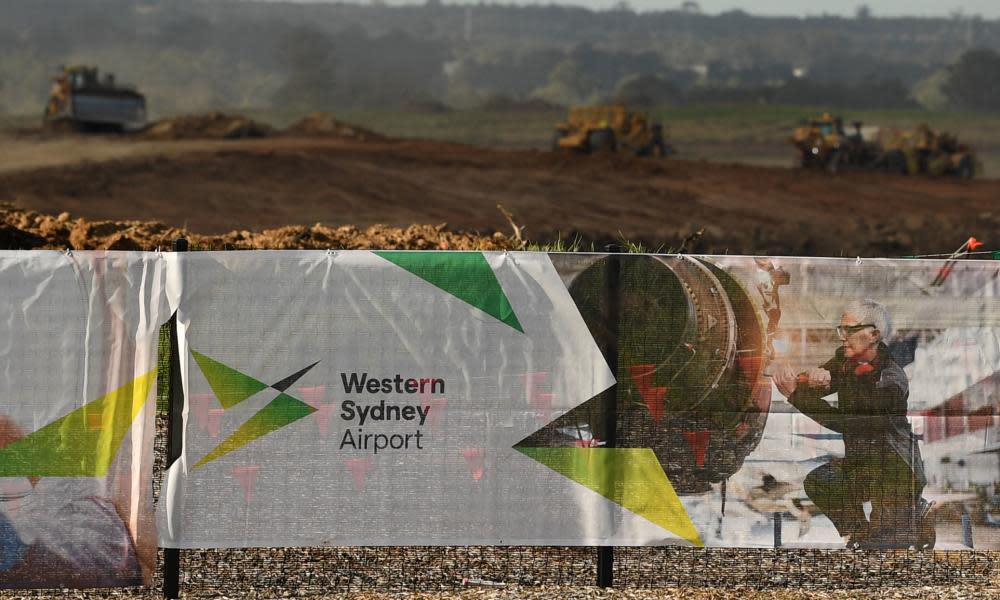Government paid 10 times too much for land at Western Sydney airport to be used after 2050

Taxpayers stumped up $26.7m too much for land to build a second runway at Western Sydney airport after 2050, the auditor general has found.
In a scathing report, released on Monday, the Australian National Audit Office (ANAO) found the $30m price tag paid by the infrastructure department was almost 10 times its fair value.
The price was four times the next highest valuation and 22 times higher than the rate the New South Wales government paid for its portion of the Leppington Triangle.
But the department has defended the “unorthodox” valuation, arguing it paid a premium to avoid costly legal disputes.
Related: Lord Sugar tweets about flight to Sydney, angering Australians unable to enter country
The ANAO found departmental officials acted unethically by failing to advise ministers how much they proposed to pay the landowner and for not providing accurate answers when it investigated the sale.
On 31 July 2018, the federal government purchased the 12.26 hectare triangular parcel of land in Bringelly, NSW, adjacent to the site of Sydney’s second airport. It paid the Leppington Pastoral Company $29.8m.
The company operates one of Australia’s largest dairy farms, and had fought a 10-year battle against compulsory acquisition of part of its land from 1989 to 1999. It is also a donor to the Liberal party, contributing a $25,000 donation in 2018-19.
The airport is due to open in 2026, but the land in the Leppington Triangle was purchased for a second runway, expected to be needed after 2050.
Only 11 months after the purchase, the land was valued at just $3.1m, triggering an ANAO investigation.
The ANAO concluded the department “did not exercise appropriate due diligence” and that its operations “fell short of ethical standards”.
The department had claimed that an early purchase would help it capitalise on “goodwill” from the landowner. In fact, it resulted in “incentivising an unwilling seller to dispose of their land some 32 years in advance of when it was anticipated to be needed for the airport expansion”, the ANAO said.
The ANAO said the department gave the valuer “inappropriate instructions” not to carry out the usual enquiries for assessing market value, producing a “restricted assessment” with a lower level of assurance.
The department originally proposed to ask the valuer to base the estimate on the “highest and best use” of the land, but after negotiations with the landowner, added a requirement to considers its “speculative industrial re-zoning potential”.
The valuer warned the formula would produce a figure “significantly higher” than current prices, reflecting a value that might be achieved 10 years in future.
The department had eight prior valuations, ranging from $920,000 based on its rental value and $1.3m based on the NSW valuer-general’s assessment at the lower end, up to $6m in Roads and Maritime Services’ 2017 evaluation. Instead, it paid the landowner $29.8m, or $2.4m per hectare.
The ANAO found the department did not give appropriate consideration to early acquisition of the land, with “questionable” benefits and “no documented consideration of costs”.
The second runway will not be required until the airport has 37m passengers a year – the current level of Melbourne’s Tullamarine airport.
“The department did not provide the ANAO with accurate answers when questions were first asked about the valuation approach, which was not ethical behaviour,” the ANAO said.
“Decision-makers were not appropriately advised on the land acquisition. Formal briefings omitted relevant information, such as: the purchase price; that the price exceeded all known market valuations of the land; and the method of acquisition.”
The infrastructure department’s Western Sydney unit is responsible for administering $5.3bn of federal funding for the airport and $2.9bn in the Western Sydney infrastructure plan.
The ANAO recommended the department conduct more rigorous cost benefit analysis and introduce new procedures governing valuations including taking minutes of discussions with landowners. The department agreed.
Related: Why are more than 25,000 Australians still stranded overseas, six months into the pandemic?
In its response, the department said it was “concerned” by the findings of the audit and “is taking actions to address any shortcomings in the processes and decision making arrangements”.
“In light of the allegation of individual breaches of integrity, the matters raised by the ANAO in the report are being investigated to ensure all such matters are fully understood and appropriate action can be taken.”
The department noted the ANAO’s view the purchase could have been made at a much later date, but argued “early acquisition provided certainty to stakeholders for long-term planning”.
“The department agrees that the valuation strategy was unorthodox.”
“However, we note that the strategy was developed in consultation with the department of finance and the Australian government solicitor and was designed to mitigate the risk of costly and lengthy legal challenges.”


